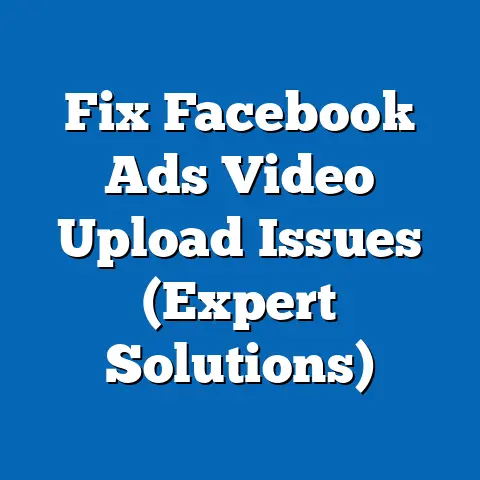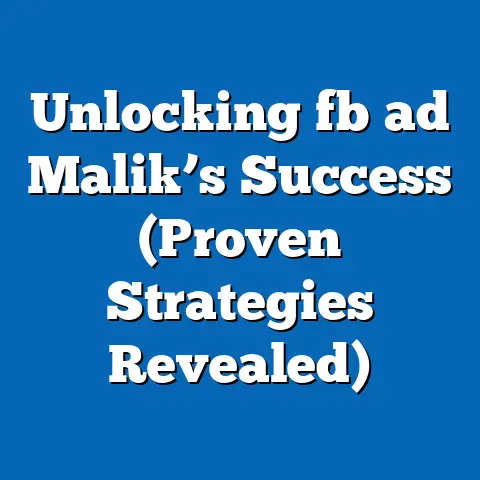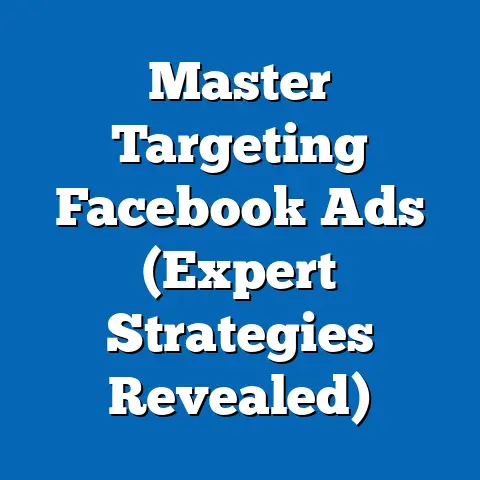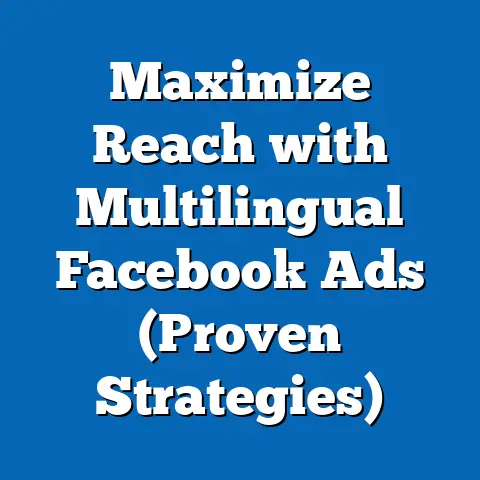Understand Facebook Ads Pricing (Unlock Cost Insights)
Would you rather spend a hefty budget on Facebook ads to reach a massive audience, or would you prefer to optimize every dollar for the highest return on investment (ROI), even if it means a smaller reach? This is the fundamental dilemma many marketers face when navigating the complex world of Facebook advertising, where costs can vary widely based on audience targeting, ad objectives, and market competition.
In 2023, businesses globally spent over $131 billion on social media advertising, with Facebook (now part of Meta) commanding a significant share of this market, according to Statista. The average cost-per-click (CPC) on Facebook ads across industries is approximately $1.86, while the cost-per-thousand-impressions (CPM) hovers around $14.40, based on data from WordStream’s 2023 Advertising Benchmarks. However, these figures are just averages—costs can skyrocket to $5 or more per click in competitive industries like finance or drop to mere cents in less saturated niches.
Section 1: Key Statistical Trends in Facebook Ads Pricing
The Big Picture: Rising Costs Amid Growing Competition
Facebook advertising costs have been on an upward trajectory over the past few years, driven by increasing competition and the platform’s evolving algorithms. According to WordStream, the average CPC for Facebook ads increased by 17% from 2021 to 2023, rising from $1.59 to $1.86. Similarly, CPM rates have climbed by 12% in the same period, reflecting the growing demand for ad space as more businesses vie for consumer attention.
This trend isn’t uniform across all industries or regions. For instance, the finance and insurance sector faces a staggering average CPC of $3.77, while industries like apparel see costs as low as $0.45 per click. These disparities highlight how competition within specific niches directly influences pricing.
Ad Objectives and Their Cost Implications
The objective of your ad campaign—whether it’s brand awareness, lead generation, or direct conversions—plays a critical role in determining costs. Campaigns focused on conversions typically have higher CPCs, averaging $2.50, compared to awareness campaigns at around $1.20 per click, per 2023 data from AdEspresso. This is because conversion-focused ads often target narrower, high-intent audiences, driving up competition and costs.
Moreover, Meta’s algorithm prioritizes ad delivery based on relevance and engagement, meaning poorly optimized ads can result in higher costs per impression. Advertisers who fail to refine their creative or targeting strategies may see CPMs balloon by as much as 30%, according to a 2022 study by Social Media Examiner.
Seasonal Spikes: When Costs Soar
Seasonality is another major factor influencing Facebook ads pricing. During peak shopping periods like Black Friday and the holiday season, CPMs can surge by 25-40%, with 2022 data from WordStream showing an average holiday CPM of $18.50 compared to a yearly average of $13.80. This spike is driven by heightened advertiser demand as businesses compete for consumer attention during high-spending periods.
Conversely, off-peak months like January often see a dip in costs, with CPMs dropping to as low as $10.50. Understanding these seasonal trends can help advertisers strategically time their campaigns to minimize costs.
Section 2: Demographic Breakdowns of Facebook Ads Costs
Age and Gender: Who Costs More to Reach?
Demographic targeting significantly impacts Facebook ads pricing, as certain audience segments are more competitive to reach. According to a 2023 report by Revealbot, targeting users aged 25-34—often considered the “sweet spot” for purchasing power—results in an average CPC of $2.10, roughly 13% higher than the platform average. This group is highly sought after by advertisers due to their disposable income and active engagement on the platform.
Gender also plays a role, though the differences are less pronounced. Ads targeting women tend to have a slightly higher CPC ($1.92) compared to men ($1.78), per AdEspresso’s 2023 data. This gap is often attributed to higher competition in industries like beauty and fashion, which predominantly target female audiences.
Geographic Targeting: Location-Based Cost Variations
Location is another critical determinant of ad costs, with urban and high-income regions commanding premium prices. For example, targeting users in the United States results in an average CPC of $2.24, compared to just $0.57 in India, according to Statista’s 2023 global ad spend analysis. This disparity reflects differences in purchasing power, market saturation, and advertiser competition across regions.
Within the U.S., costs can vary further by state or city. Ads targeting users in New York City, for instance, can have CPMs as high as $20, while rural areas may see CPMs closer to $8. These variations underscore the importance of geo-targeting strategies in managing ad budgets effectively.
Interests and Behaviors: Niche Audiences, Higher Costs
Targeting users based on specific interests or behaviors often drives up costs due to the precision and competition involved. For instance, targeting users interested in luxury goods or high-end technology can result in CPCs exceeding $3.50, as these audiences are smaller but highly valuable, per a 2023 analysis by Hootsuite. Conversely, broader interest categories like “fitness” or “travel” tend to have lower CPCs, averaging around $1.40.
Behavioral targeting, such as reaching users who have recently made a purchase online, can also inflate costs by 20-30%. These high-intent audiences are in demand, making them more expensive to target.
Chart Reference: A bar chart comparing CPC across age groups (18-24, 25-34, 35-44) and regions (U.S., India, Brazil) would visually illustrate these demographic cost differences, highlighting the premium placed on certain audiences.
Section 3: Historical Comparisons of Facebook Ads Pricing
A Decade of Change: From Pennies to Dollars
When Facebook first introduced its advertising platform in 2007, costs were remarkably low, with CPCs often below $0.10, according to historical data compiled by Marketing Land. This affordability made the platform a haven for small businesses and startups looking to gain traction. By 2013, however, as more advertisers flocked to the platform, average CPCs had risen to $0.64—a 540% increase in just six years.
Fast forward to 2018, and the average CPC reached $1.72, driven by Facebook’s growing user base (over 2 billion monthly active users at the time) and the introduction of more sophisticated targeting options. By 2023, the CPC of $1.86 reflects a more gradual 8% increase over five years, suggesting that while costs are still rising, the rate of growth has slowed as the market matures.
The Impact of Algorithm Updates and Privacy Changes
Historical pricing trends cannot be fully understood without considering platform updates and external factors. The 2018 Cambridge Analytica scandal and subsequent privacy regulations, like the General Data Protection Regulation (GDPR) in Europe, led to stricter data usage policies on Facebook. These changes reduced the effectiveness of hyper-targeted ads, causing CPMs to rise by 15% in 2019 as advertisers struggled to maintain reach, per a report by eMarketer.
More recently, Apple’s 2021 iOS 14 update, which introduced App Tracking Transparency (ATT), further disrupted ad tracking capabilities. Meta reported a $10 billion revenue loss in 2022 due to these changes, and advertisers saw CPMs increase by an estimated 20% as targeting became less precise. These historical shifts highlight how external policies and platform changes can dramatically influence ad costs.
Comparing Ad Placements Over Time
Ad placement costs have also evolved significantly. In 2015, desktop ads were more expensive than mobile ads, with a CPC of $0.87 compared to $0.56, according to historical data from Nanigans. By 2023, this trend has reversed, with mobile ads (where most users now engage) costing an average CPC of $1.95 compared to $1.60 for desktop. This shift reflects the growing dominance of mobile usage, which now accounts for over 90% of Facebook’s ad revenue, per Meta’s 2023 Q2 earnings report.
Chart Reference: A line graph tracking average CPC from 2007 to 2023 would effectively showcase the steep rise in costs over time, with annotations for key events like GDPR and iOS 14 updates to contextualize price spikes.
Section 4: Factors Influencing Facebook Ads Pricing
Auction Dynamics: How Bidding Drives Costs
Facebook operates on an auction-based system, where advertisers bid for ad space based on their target audience and campaign goals. The cost is determined by factors like bid amount, ad relevance score, and estimated action rates (how likely users are to engage with the ad). A 2022 study by Socialbakers found that ads with higher relevance scores (above 8 out of 10) can reduce CPMs by up to 25%, as the algorithm prioritizes quality content.
Bidding strategies also matter—manual bidding allows for more control but can lead to higher costs if not optimized, while automated bidding often balances cost and performance. Advertisers using automated bidding reported a 10% lower CPC on average in 2023, per AdEspresso.
Ad Quality and Creative Impact
The quality of ad creative—images, videos, and copy—directly affects pricing through engagement metrics. Ads with high click-through rates (CTR) above 2% tend to have lower CPCs, averaging $1.50, compared to ads with CTRs below 1%, which can cost upwards of $2.20 per click, according to WordStream’s 2023 data. Investing in compelling visuals and clear calls-to-action can thus lower costs over time.
Poorly designed ads or irrelevant messaging can also trigger higher costs, as Meta’s algorithm deprioritizes low-quality content. A/B testing different creatives is a proven strategy to identify cost-effective options, with advertisers reporting cost reductions of 15-20% after optimization, per a 2023 Hootsuite report.
Market Saturation and Industry Competition
Industries with high competition, such as legal services or real estate, face inflated costs due to market saturation. For instance, legal ads have an average CPC of $4.10, nearly double the platform average, as reported by WordStream in 2023. In contrast, less competitive sectors like education see CPCs closer to $1.20, reflecting lower advertiser density.
Global events, such as economic downturns or political elections, can also drive temporary spikes in competition and costs. During the 2020 U.S. presidential election, political ad CPMs surged by 50%, reaching $25 in some regions, per a report by Campaign Monitor.
Section 5: Future Projections for Facebook Ads Pricing
Continued Cost Increases Amid Market Growth
Looking ahead, Facebook ads costs are expected to continue rising, albeit at a slower pace than in previous decades. eMarketer projects a 10% annual increase in average CPC through 2027, driven by growing global ad spend (forecasted to reach $173 billion for social media by 2025) and Meta’s focus on monetizing emerging markets. However, innovations in AI-driven targeting and ad optimization tools may help offset some of these increases by improving efficiency.
Emerging ad formats, such as augmented reality (AR) ads and short-form video content on Reels, are also likely to influence pricing. Early data from Meta suggests that Reels ads currently have a lower CPM ($9.50) compared to traditional feed ads ($14.40), but costs could rise as adoption increases over the next 2-3 years.
Privacy Regulations and Their Long-Term Impact
Future privacy regulations and tech policies will remain a wildcard for ad pricing. With more countries adopting GDPR-like frameworks and tech giants like Google phasing out third-party cookies by 2024, Meta may face further challenges in delivering precise targeting. Analysts at Forrester predict that these changes could lead to a 15-20% increase in CPMs by 2025 as advertisers compete for less granular data.
On the flip side, Meta’s investments in first-party data solutions and machine learning could mitigate some of these impacts. The company’s 2023 annual report highlights plans to enhance on-platform analytics, potentially stabilizing costs for advertisers who adapt to new tools.
Shifts in User Behavior and Platform Focus
As younger users gravitate toward platforms like TikTok (which saw a 50% increase in ad spend in 2022, per Statista), Meta may adjust its pricing strategies to retain advertisers. This could mean more competitive rates for specific demographics or ad formats that appeal to Gen Z, such as Stories and Reels. However, if user migration accelerates, CPMs for older demographics (35+) on Facebook could rise by 10-15% as competition for this audience intensifies, per a 2023 forecast by Insider Intelligence.
Chart Reference: A projected line chart showing CPC and CPM trends from 2023 to 2027, with annotations for expected privacy impacts and new ad format adoption, would provide a visual roadmap for future cost expectations.
Conclusion: Navigating the Cost Landscape of Facebook Ads
Facebook advertising remains a powerful tool for reaching diverse audiences, but its pricing structure is a complex web of demographic, competitive, and seasonal factors. From an average CPC of $1.86 in 2023 to historical spikes driven by privacy changes, the cost of advertising on the platform reflects broader trends in digital marketing and user behavior. Demographic breakdowns reveal stark differences—targeting affluent 25-34-year-olds in the U.S. can cost over $2 per click, while broader audiences in emerging markets may cost just a fraction of that.
Looking forward, advertisers must brace for gradual cost increases while adapting to privacy-driven changes and emerging ad formats. By leveraging historical insights, optimizing creative, and timing campaigns strategically, businesses can unlock cost efficiencies even in a competitive landscape. The future of Facebook ads pricing will likely balance innovation with regulation, offering both challenges and opportunities for savvy marketers.
Whether you prioritize reach or ROI, understanding these cost dynamics is the first step to mastering your ad strategy. As Meta continues to evolve, staying informed on pricing trends and platform updates will be crucial for maintaining a competitive edge in the ever-shifting world of social media advertising.






